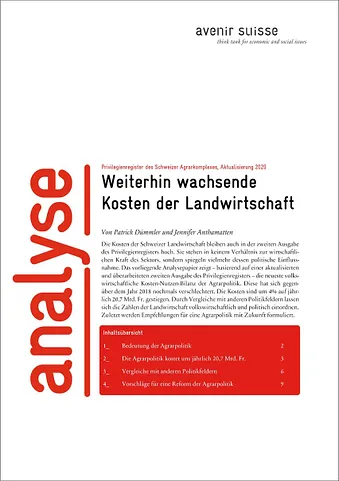In fall 2018, Avenir Suisse estimated the costs of Swiss agricultural policy to the economy as a whole at around CHF 20 billion a year. In the meantime, the figure has risen 4% to CHF 20.7 billion. This is the finding of the updated register of privileges enjoyed by Swiss agriculture, which lists the macroeconomic costs of agricultural policy in detail. In parallel, Avenir Suisse has published a paper analyzing the figures and outlining possible solutions.
Avenir Suisse’s register of privileges enjoyed by the agricultural sector (published in German and French as Avenir-Suisse-Privilegienregister der Schweizer Landwirtschaft/Registre des privilèges de l’agriculture suisse) tracks the proliferation and diversity of farming subsidies in Switzerland. Since publication of the first edition of this agricultural cost-benefit analysis in 2018, there has been another increase in the overall economic costs, up 4% to CHF 20.7 billion a year. Taxpayers foot 23% of this bill and consumers 18%; 37% is environmental costs, and 22% is borne by business in the form of missed export opportunities. The CHF 700 million increase in costs in the space of 16 months is due in large part to the greater prominence of environmental costs in the overall calculation. Use of pesticides, excess phosphorous, and loss of biodiversity alone account for an additional CHF 300 million per year. In certain cases, agricultural subsidies even encourage − or at least fail to penalize − environmentally damaging behavior (for example the reduced VAT rate on plant protection products).
The agricultural lobby regularly cites “farming families in difficulty” as political justification for the raft of subsidies and preferential treatment – despite the fact that it’s probably these families that benefit the least from the current system, as considerable portions of the tax francs go via farmers into up- and downstream sections of the agricultural value chain.
Swiss farmers are under pressure from two sides: they have to pay high prices for agricultural production factors, and they have to contend with slim margins when they sell their produce to processors and retailers. Every year, each private household in Switzerland contributes around CHF 2,300 to fund this policy: a consumer family shoulders CHF 1000, the lion’s share resulting from rigid border protection for agricultural goods, while a further CHF 1300 is calculated to flow to the agriculture sector by way of tax.
In a paper accompanying the update, authors Patrick Dümmler and Jennifer Anthamatten analyze the economic costs identified in the register of privileges and compare them with government expenditure in other areas.
They calculate, for example, that on the basis of federal and cantonal expenditure, Switzerland spends three times as much on the agricultural sector as on the ETH Zurich. They also compute that a per-son employed in agriculture receives almost 25 percent more public money a pensioner gets in state pension. Another finding is that in a time of generally greater awareness of environmental issues, the state spends the same amount on agriculture as on protecting the environment.
Swiss agricultural policy is in need of fundamental reform. Possible approaches include opening up the borders for agricultural produce, redefining security of supply, and abandoning transfers designed to maintain structures. Another measure should be to make the provision of public services into public agricultural services and put them out to tender. In addition, regulation should be reduced and entrepreneurial aspects should be given more emphasis in agricultural policy. Farming more appropriate to the setting, sector agreements, technical innovation, and incentive taxes on environmentally damaging consumables could reduce expenditure by billions while reducing the burden on the environment.





